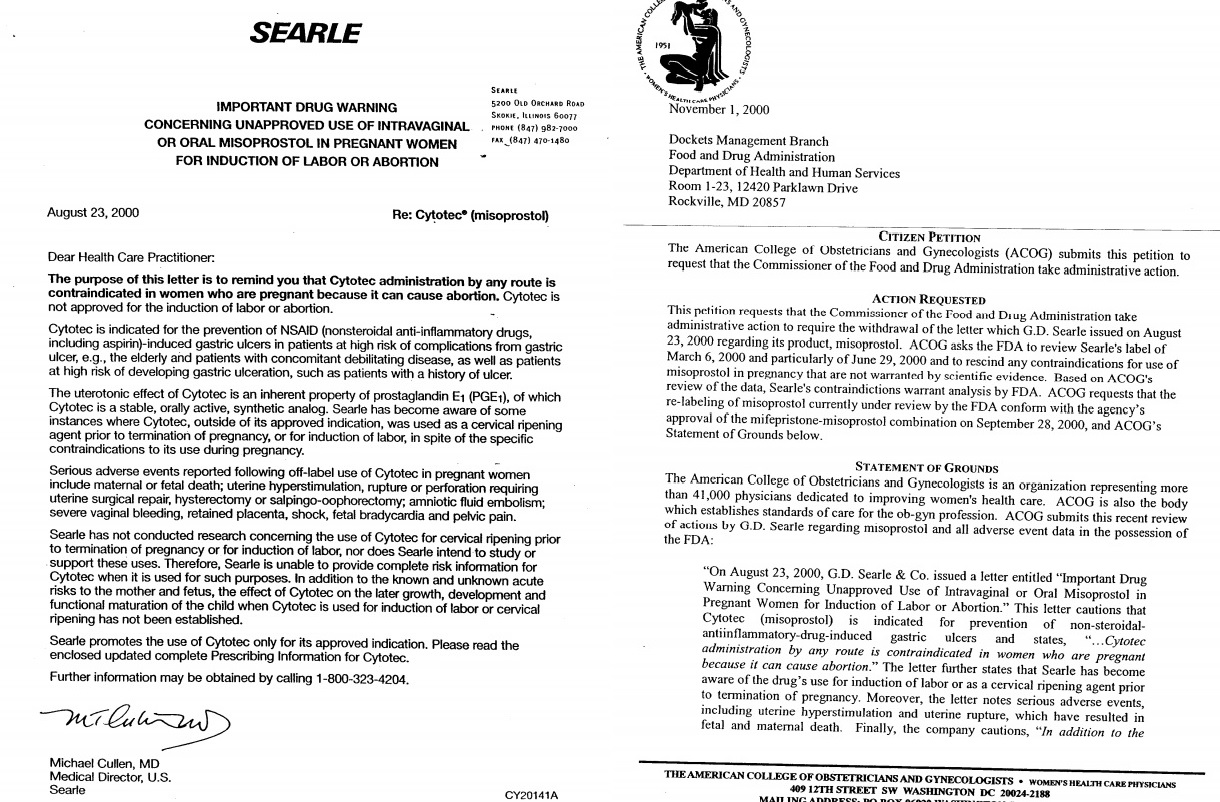The abortion pill (mifepristone) was first approved by the Food and Drug Administration (FDA) on September 28, 2000, in a regimen with another drug called misoprostol. Shortly after the abortion pill was approved, women began dying.* In years since its approval (between 2000 and 2018), the abortion pill has ended the lives of nearly four million preborn children and has caused thousands of serious adverse effects.
How the abortion pill came to the United States
In 1992, Ron Weddington — a co-counsel for the plaintiff in Roe v. Wade and the ex-husband of Roe attorney Sarah Weddington — wrote an open letter to the Bill Clinton administration recommending that the president “eliminate” certain segments of society via abortions, the RU-486 abortion pill (mifepristone or Mifeprex), and other means.
In 1993, President Clinton signed an executive order directing the FDA to expedite marketing of RU-486. In 1994, his administration pressured the French pharmaceutical manufacturer Roussel-Uclaf to assign the U.S. rights of marketing and distribution to the Population Council. This eugenics-founded “non-profit” brought the abortion pill into the U.S. and later set up the pill’s manufacturer, Danco Laboratories, LLC, a sub-licensee of the Population Council.
One little known fact about the abortion pill is that it has ties to the manufacturer of the deadly gas Zyklon-B, used by the Nazis during the Holocaust.
The abortion pill’s manufacturer
Initially, the abortion pill’s manufacturer was kept secret, as were the company’s principles and investors — so secret that many media outlets even questioned it. Eventually news leaked out that the Population Council had set up Danco as the U.S. manufacturer. Then, in 2019, the FDA approved the generic manufacturer of the abortion pill: GenBioPro, Inc.
The location of Danco’s manufacturing plant remains elusive even today, but reports from 2008 identified China-based Shanghai Hualian (tied to tainted leukemia drugs) as the sole supplier of mifepristone to the U.S.
A 1997 report by the Washington Post indicated that the abortion pill was initially projected to reach $100 million in sales every year. Today, it is estimated that the abortion industry could gross nearly $200 million annually in abortion pill sales — twice as much money as initially projected.
The abortion pill’s financiers
Danco was started with funding from several abortion philanthropy groups, including a $14 million loan from the David and Lucile Packard Foundation. Packard would go on to fund Gynuity Health Projects, which is currently conducting abortion pill clinical trials, as well as a number of studies, to further increase access to the pills. Packard also funds the previously mentioned manufacturer, GenBioPro.
A 2002 report by the Los Angeles Times noted how abortion philanthropists Open Society Foundations (the philanthropic arm of billionaire George Soros), and the California-based Kaiser Family Foundation also helped finance Danco. Internal documents reviewed by the Wall Street Journal indicate that Warren Buffett and others helped with financing. And according to a 2000 Washington Post report, “The Buffett Foundation… made at least $2 million in interest-free loans to the Population Council… according to tax documents filed in 1995. That money was in turn used to conduct clinical trials of RU-486.”
The FDA politicized the process
Reports indicate that the FDA itself politicized the abortion pill’s approval process by choosing not to publish the names of “experts” who reviewed the drug. The Washington Post noted that the FDA “broke with precedent by not publishing the names of the experts who reviewed RU-486 for the agency.”
Interviewers from Columbia University who spoke to those involved with the Population Council’s approval process at that time noted that the names of the FDA staff involved with approving the abortion pill have never been released.
They were able to somehow track down one of the FDA’s senior medical reviewers who “chose to remain anonymous” but admitted, “It’s definitely not standard. It’s not routine, you can look up almost every other drug that I was the primary medical officer for and my name would appear right there on the review.”
Today, the pill’s manufacturing location and many of its funders are still cloaked in secrecy.
What is misoprostol?
The second drug in the abortion pill regimen, misoprostol, is an ulcer drug originally manufactured by Searle under the brand name Cytotec. It was first registered in Brazil in 1986 and was sold in pharmacies and drug stores without a prescription. It was later approved in the United States by the FDA in December of 1988. In 1985, Monsanto purchased G.D. Searle & Company as “a way for Monsanto to bring to market the drugs it is developing in its biotechnology laboratories,” according to a report by the New York Times.
In his book “The Abortion Pill,” French researcher Etienne-Emile Baulieu noted misoprostol’s use in countries where abortion was illegal, claiming that he had personally “bought misoprostol in pharmacies to experiment with the drug as an abortifacient.”
He wrote “In the future, the availability and convenience of misoprostol may become crucial if RU-486 is offered under more private conditions than in abortion clinics.”
Just prior to the FDA’s approval of RU-486, Searle issued a “Dear Health Care Practitioner” letter emphasizing that Cytotec was contraindicated for use in pregnant women and not approved for induction of labor or abortion. Within a few months, the American College of Obstetricians and Gynecologists (ACOG) a pro-abortion organization, responded with a citizens petition requesting that the FDA Commissioner “take administrative action to require the withdrawal” of Searle’s letter and to “rescind any contraindications for use of misoprostol in pregnancy” on the drug’s label to “conform with the agency’s approval of the mifepristone-misoprostol combination on September 28,2000….”
Which is exactly what the FDA did.

Searle dear healthcare letter on Cytotec as abortion drug and ACOG citizen petition to withdraw
How safe is the abortion pill?
Live Action News has previously detailed the FDA’s concerns over the safety of the abortion pill in past years. This is why in April 2011, the FDA determined that a safety requirement known as REMS was necessary for mifepristone.
In December of 2018, the FDA reported 24 deaths* associated with the abortion pill since its approval. Nearly 4,200 adverse events have been reported, including 1,042 hospitalizations, nearly 600 instances of blood loss requiring transfusions, and other serious complications. Despite Live Action News’ repeated requests to the FDA, the agency has not updated the numbers on abortion pill deaths or overall distribution since 2018.
It is important to note that under 2016 changes, Danco is no longer mandated to notify the FDA of complications other than death, so no one may ever know just how many women have been injured by the abortion pill. But as abortion pill access increases, it is likely that complications (where they are even tracked) will rise as well. In addition, a recent analysis revealed that abortion pill clients experiencing complications are more likely to receive care from an emergency center than the abortion facility where they obtained the pills, potentially limiting reporting further.
Where are we today?
Last year, the abortion industry expanded abortion pill clinical trials and rolled out a ‘no-test’ abortion protocol under the guise of COVID-19, despite the fact that they had this plan in the works prior to the pandemic. In April of 2021, the Biden FDA temporarily enabled abortion pill distribution by mail during COVID-19 pandemic but made the change permanent as of December 2021, when it weakened the REMS safety requirements by eliminating the in-person dispensing requirement and enabling the abortion pill to be shipped by mail. Then, on January 3, 2023, the Biden FDA went even further, by allowing the abortion pill to be sold through retail pharmacies with a prescription.
Today, the abortion industry is seeking to lift the REMS on the abortion pill and expand its use through self-managed and DIY abortion. This process puts the responsibility of seeing the remains of the child and disposal of “fetal remains” squarely on the teenager or woman taking the pills. Additional schemes by abortion insiders involve committing abortions past the approved FDA gestational age limit, knowing the failure rate of the abortion pill increases with gestational age. In addition, they have proposed “advanced provision” of the pills before pregnancy, pushing unregulated online abortion pill dispensaries, and even illegal distribution of the drug.
Abortion groups are also pressuring Big Tech to censor information on abortion pill reversal (APR) knowing that the process, which involves administration of the time-proven drug progesterone, has saved 2,000 lives.
Despite the potentially dangerous impact of expanding abortion pill access, the media refuses to investigate many conflicts of interest and ties by study authors and commentators to Danco or GenBioPro, claiming it is safe.
*THE FDA HAS RECEIVED REPORTS OF SERIOUS ADVERSE EVENTS IN PATIENTS WHO TOOK MIFEPRISTONE. AS OF JUNE 30, 2022, THERE WERE 28 REPORTS OF DEATHS IN PATIENTS ASSOCIATED WITH MIFEPRISTONE SINCE THE PRODUCT WAS APPROVED IN SEPTEMBER 2000, INCLUDING TWO CASES OF ECTOPIC PREGNANCY (A PREGNANCY LOCATED OUTSIDE THE WOMB, SUCH AS IN THE FALLOPIAN TUBES) RESULTING IN DEATH; AND SEVERAL FATAL CASES OF SEVERE SYSTEMIC INFECTION (ALSO CALLED SEPSIS). THE ADVERSE EVENTS CANNOT WITH CERTAINTY BE CAUSALLY ATTRIBUTED TO MIFEPRISTONE BECAUSE OF CONCURRENT USE OF OTHER DRUGS, OTHER MEDICAL OR SURGICAL TREATMENTS, CO-EXISTING MEDICAL CONDITIONS, AND INFORMATION GAPS ABOUT PATIENT HEALTH STATUS AND CLINICAL MANAGEMENT OF THE PATIENT. A SUMMARY REPORT OF ADVERSE EVENTS THAT REFLECTS DATA THROUGH JUNE 30, 2022, IS HERE. THE FDA HAS REVIEWED THIS INFORMATION AND DID NOT IDENTIFY ANY NEW SAFETY SIGNALS. THE FDA INTENDS TO UPDATE THIS SUMMARY REPORT AS APPROPRIATE.
Editor’s Note 1/6/23: This article was updated with new information.
“Like” Live Action News on Facebook for more pro-life news and commentary!







